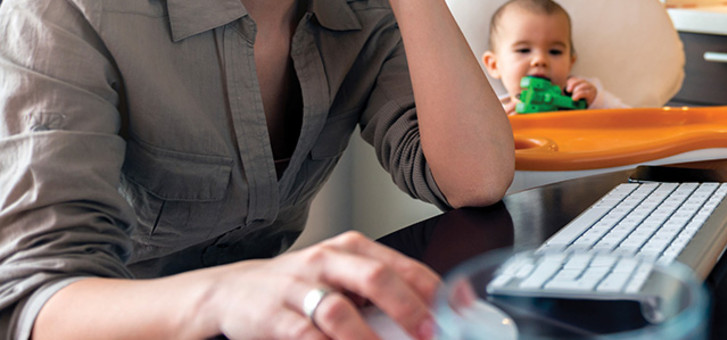A recent Australian survey has found that as many as 51 per cent of employed adults are now working from home. This percentage is likely to rise over the next few years with fresh advances in technology, an increasing frustration with commuting, concern for the environment and easy access to online global markets.
I began working from home six years ago when my husband’s job moved us to a remote location. I had a choice: spend 25 hours a week commuting or figure out a way to work from home. So I began developing a career as a freelance writer.
There are dozens of other ways to work from home. Some people telecommute. They use computers, phones and networking technology to do their office job from home. Others are self-employed and run “kitchen table” businesses such as crafting, blogging, designing, accounting, writing, growing orchids or being virtual office assistants.
Working from home has plenty of benefits. Most telecommuters and home-workers enjoy the flexible hours, and almost one-third say they’re more productive when they work from home.
Home workers save hundreds of dollars on travel costs, lunches, snacks and work clothes; they get less involved in tricky office politics; and they don’t have the hassle of traffic jams and parking tickets. Parents also appreciate not having to worry about child care during the school holidays or who’ll look after the children if they’re sick.
American statisticians have suggested that if everyone in the United States who could work from home did so for only half their working days, the total savings could amount to more than $US700 billion per year. This includes a saving for individual workers of $US2000–$US7000 per year, as well as a saving for businesses of about $US11,000 per employee per year. The total fuel saved by this increase in telecommuting could equal about 37 per cent of the Persian Gulf oil imported to the United States.
A recent survey highlighted the correlation between people’s happiness and the length of their commute: the less time they spent travelling to work, the happier they were. Maybe it was because they didn’t have to drive through heavy traffic; or because they could spend more time with their family or doing things they enjoyed; or because when they worked within their home, they were more likely to have a social network within their local community.
Made for togetherness
However, studies have also revealed that one of the hardest things about working from home is isolation. You can go an entire day without speaking to anyone. There’s no-one to chat with during lunch and no friends to bump into in the corridor. Too much isolation can have negative effects on our physical and psychological health.
According to John Cacioppo, a psychologist from the University of Chicago (US), lonely people are more likely to have high blood pressure and higher levels of stress hormones in their bloodstream. People who are isolated usually sleep less and have a poorer quality of sleep, so their bodies can’t repair themselves as effectively. They also experience a higher risk of suicide. Aloneness, it has been proven, is bad for us.
“Meeting people is tricky,” says Luke. “I don’t work a nine-to-five job. One week I’ll have five design deadlines and the next week I won’t have any. I try to spread my workload, but sometimes I have to work more than 12 hours a day just to keep ahead. I tried making plans to hang out with friends and then felt bad when I couldn’t make the appointments. So now I don’t bother to plan. I’ve learned to be more spontaneous.”
There’s an amazing moment in the Creation story: God has just created Adam, a perfect being in a perfect environment without any pain or sin. Adam can even talk to God face-to-face every single day! What could be better than that? But God tells him that there is still something missing in his life, something that made it imperfect. He said, “It is not good for the man to be alone” (Genesis 2:18).
We were created for relationships in which we can be encouraged, comforted, loved, appreciated and supported. Only then we can flourish. And so, just when many people are moving toward working from home, some businesses are working harder than ever to bring people together. They’ve discovered that many creative initiatives start during chance encounters between people and they’re designing workspaces that create opportunities for these meetings to happen.
Julia tackles her loneliness by linking up with other remote website designers. They Skype each other every morning at nine and talk about their to-do lists, share challenges and ideas, and tell each other what they hope to achieve. At 4.30 pm they have another virtual meeting where they share what they’ve done during the day.
“The Skype meetings help me feel less isolated,” Julia says. “It’s like I have colleagues again. We energise each other and we’re much more efficient because we can keep each other accountable.”
Martin telecommutes for a large company. “I work from home,” he says, “so I don’t see many of my colleagues. We use Skype to stay in touch because we can easily see who’s free for a chat and who doesn’t want to be disturbed. We try to have at least two Skype chats a day to help us stay connected with each other. Sometimes we synchronise our breaks and just hang out on Skype for 20 minutes.”
Ancient wisdom
Sometimes we just need to find someone to work with or be with. Several thousand years ago King Solomon thought about living life alone and he wrote, “It’s better to have a partner than go it alone. Share the work, share the wealth. And if one falls down, the other helps, but if there’s no one to help, tough! . . . By yourself you’re unprotected. With a friend you can face the worst” (Ecclesiastes 4:9, 10, 12, The Message).*
For me, working from home was tough and lonely at first. But now I have a couple of other freelance jobs that involve working with a team. I enjoy the flexibility and variety. I can alternate quiet “writing days” with busy “people days.” I’m learning to notice when I need space to work on a project, when I need to find someone to help me and when I need to go for a walk with a friend.
If you’re working from home, it’s important to find the best work-social balance for you: one that enables you to get your work done without too many interruptions and one that gives you just the right amount of social connection to keep you happy, healthy and inspired.
Feeling isolated? Try Jelly
A “Jelly” is a co-working event where home workers and telecommuters come together in one place to work alongside each other. Jelly started in a New York apartment. It’s called a Jelly because there were some jelly beans on the table when the first group was wondering what to call their co-working event.
A Jelly is not a place to promote yourself and your business. It’s a place to share ideas, meet new people and have fun. All you need is a free meeting place like a community centre, café, church hall, hotel lounge or start-up business hub. The venue needs to have fast internet access, tables, power sockets and a place where people can buy food and drinks. Some places are willing to host a Jelly event because they want to promote their venue, sell refreshments and create a social buzz.
Jellies are relaxed. You don’t have to arrive and leave at specific times. Jellies can happen weekly, monthly or as often as the group wants to meet. You can find Jellies through social media networks such as meetup.com.






